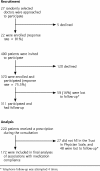Physician-patient relationship and medication compliance: a primary care investigation
- PMID: 15506581
- PMCID: PMC1466710
- DOI: 10.1370/afm.139
Physician-patient relationship and medication compliance: a primary care investigation
Abstract
Purpose: We assessed the relationship between 4 attributes of the physician-patient relationship and medication compliance.
Methods: We conducted a waiting room survey of patients consulting 22 general practitioners in 14 randomly selected practices in Auckland, New Zealand (81% response rate). A total of 370 consecutive patients (75% response rate) completed survey instruments about 4 attributes of the physician-patient relationship. Continuity of care (assessed from use of a usual physician, length of continuity, and perceived importance of continuity) and trust in the physician were ascertained before the consultation. After the consultation the Patient Enablement Index measured the physician's ability to enable patients in self-care, and concordance between the patient and physician was measured by a 6-item inventory of perceived agreement about the presenting problem and management, were ascertained immediately after the consultation. Compliance with prescribed medication therapy was ascertained by telephone follow-up 4 days after the consultation.
Results: Overall, 220 patients (61%) received a prescription, and 79% of these patients were taking the medication at follow-up. In a univariate analysis adjusted for clustering, only trust and physician-patient concordance were significantly related to compliance. In analysis further adjusted for health and demographic factors, physician-patient concordance was independently related to compliance (odds ratio = 1.34, 95% confidence interval, 1.04-1.72).
Conclusions: Primary care consultations with higher levels of patient-reported physician-patient concordance were associated with one-third greater medication compliance. An emphasis on understanding and facilitating agreement between physician and patient may benefit outcomes in primary care.
Figures
References
-
- Strasser R. The doctor-patient relationship in general practice. Med J Aust. 1992;156:334–338. - PubMed
-
- Balint J, Shelton W. Regaining the initiative. Forging a new model of the patient-physician relationship. JAMA. 1996;275:887–891. - PubMed
-
- Vedsted P, Mainz J, Lauritzen T, Olesen F. Patient and GP agreement on aspects of general practice care. Fam Pract. 2002;19:339–343. - PubMed
Publication types
MeSH terms
LinkOut - more resources
Full Text Sources
Medical

